 |
| Landscape Design | | | Boxwood | Planters | Antiques | | | Location | Events | Press | Bio | Contact |
BOXWOOD CARE
 |
Growing HEALTHY BOXWOOD
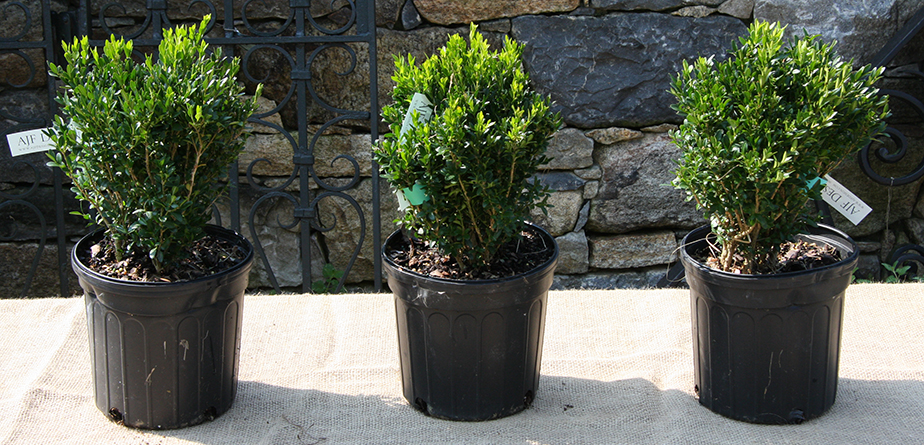 |
||
1. Choose the Right Cultivars
 |
The most important aspect in choosing boxwood cultivars is to select the cultivar that best suits your particular application.
This will allow for better long term success of your planting and reduce the amount of care necessary.
2. Plant & Care for them Appropriately
DRAINAGE
|
 |
3. Common problems - Drainage, SOil, Shearing
3A. Poor Drainage
Amend your soil to ensure proper drainage out and away from the roots.
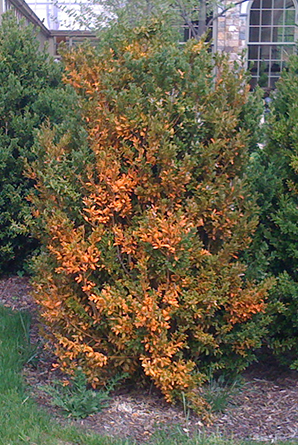 |
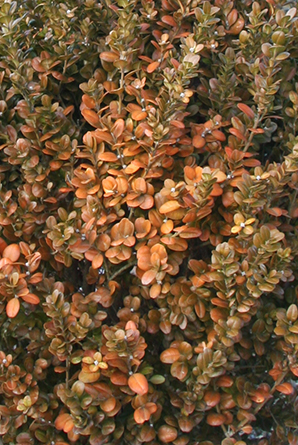 |
 |
||
| Test the permeability of your soil | ||||
3B. Poor Soil
At AJF Design we put a lot of focus on the soil.
Soil is often overlooked in traditional planting and the focus instead is on adding synthetic nutrients to try to mimic the natural process. At AJF we go back to organic practices and focus on creating a soil environment that fosters the natural nutrient cycle. This results in healthier plants that need fewer inputs of water and nutrients over the long-term. Each environment is different so it is important to first get your soil tested so that you know what you need to add to restore the natural nutrient cycling capacity of the soil.
If you boxwood are looking less than healthy, start with the soil.
 |
 |
 |
||
| Test your soil | Analyzing the soil biota | Add the necessary components | ||
3C. Poor Maintenance - Shearing
While boxwood that have been sheared can be beautiful, this is a process that leads to poor boxwood health.
If you insist on shearing your boxwood know that you are weakening the plants and will need to replace them regularly.
Why? Shearing creates a dense layer of leaves on the outer edge of the plant that does not let air or light into the center,
which is
the perfect recipe for fungal disease. Also the minimal leaf growth on the perimeter is not enough to sustain the plant.
A sheared plant will have 1/2 inches of growth compared to a properly pruned plant which will have over 2 feet.
Choose cultivars with a natural shape similar to what you are looking for and prune by hand.
Hand Pruning opens up the top and inside of the plant and allows light and air to pass through.
Always trim back to another branch and taper the cut so bottom is wider than the top of the form
 |
 |
 |
||
| Shearing is beautiful but it leads to poor health | Allow plants to grow naturally | Prune for shape, but allow light into plant | ||
4. INSECTS
4A. Psyllid
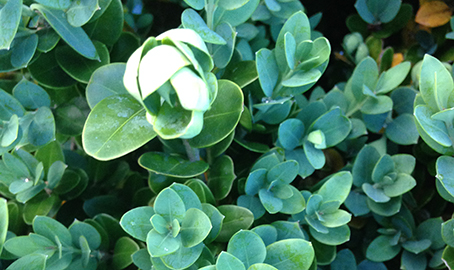 |
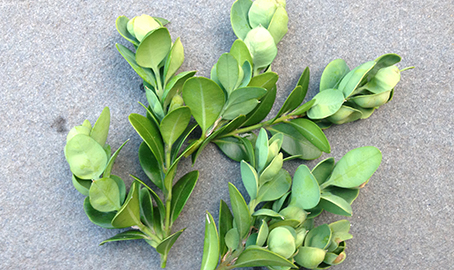 |
|
Signs of Psyllid, leaves cupping |
More signs of Psyllid, with leaves cupping | |
Psyllid is a green nymphal insect that consumes the leaf cells causing the leaf to cup
Psyllid Remedy
Early Spring - spray with horticultural oil, getting the bud scales just before the new leaves start to emerge (as bud expands)
Late Spring - spray insecticidal soap when leaves are fully out when you see the white mass on the leaves
4B. LEAF MINER
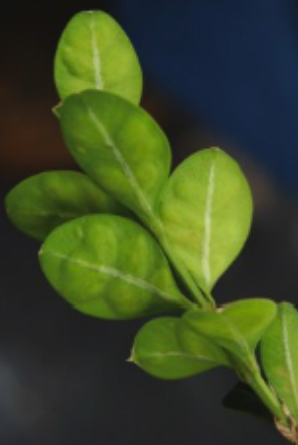 |
 |
 |
||
Blistered leaf |
Larva feeds in leaf |
Larva emerges out of the back of the leaf |
||
Leaf Miner Remedy
Early Spring - spray with horticultural oil, getting the bud scales just before the new leaves start to emerge (as bud expands)
Late Spring - spray insecticidal soap when leaves are fully out when you see the white mass on the leaves
4C. MITES
 |
||||
Mites are a type of spider.
Signs are leaf stippling or light specs, which is more evident on older leaves.
Mites pierce the epidermal cells then suck the juices of the new leaves
Mite Remedy
Spray with horticultural oil in the spring – getting the underside of the leaves where their eggs are.
It is more effective to spray when they are crawling.
4D. BOX TREE MOTH
 |
 |
|
|
||
The Box Tree Moth is an Asian moth that has has been a pest in the UK since 2006. It spread across Europe over the following ten years, reaching Canada in August of 2018. In June of 2021, shipments of infested boxwood reached select retail facilities in the US. As of 2025, the states of Massachusetts and Delaware as well as counties in western New York, southeastern Michigan, southwestern Ohio, and northern Pennsylvania are under quarantines established by APHIS (click here to view the APHIS map).
What to Look For
Box Tree Moth caterpillars are primarily lime-green in color with black heads and intermittent spiky white hairs. They have black and white stripes down their backs with black spots alongside. They grow up to 1.5 inches long. Box Tree Moth caterpillars feed on boxwood leaves and young twigs, causing plant die back. Watch for chewed leaves and bark as well as webbing from the pupa before the caterpillars hatch. Detection is critical as Box Tree Moth caterpillars will only kill boxwood if an infestation goes untreated. Adult moths are primarily active at night and are white with a thick light brown border. Click here for more photos from the USDA.
What do I do if I find Box Tree Moths?
Contact your local Cooperative Extension office or state Department of Agriculture’s plant health section immediately so they can help monitor the spread as well as provide you with the most up to date information on how to control the pest. You may need to provide them with live specimens or photos to ensure proper identification. In addition, The European Boxwood and Topiary Society has a wonderful fact sheet on their website.
5. fungus & disease
5A. cylindrocladium 'Boxwood blight'
 |
 |
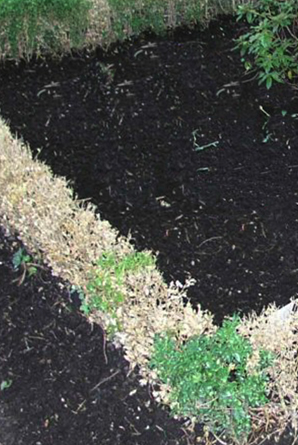 |
||
| Beginning Stages | Forms brown/black stem cankers & lesions | Planting killed by boxwood blight | ||
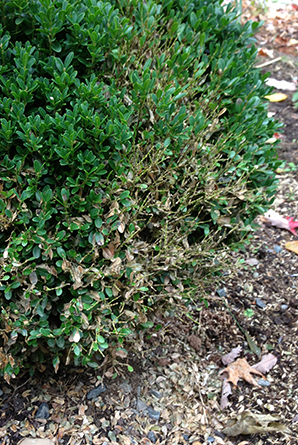 |
 |
 |
||
ABOUT
TREATMENT
|
6. MISC
DOGS
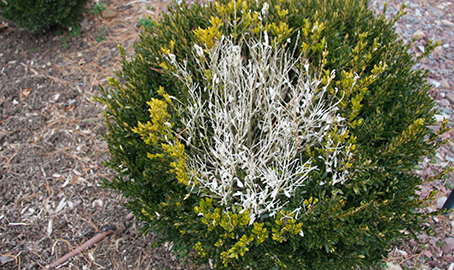 |
 |
|
| Evidence of Dog Pee on Boxwood | Curb your dog | |
LINKS TO ADDITIONAL BOXWOOD RESOURCES |
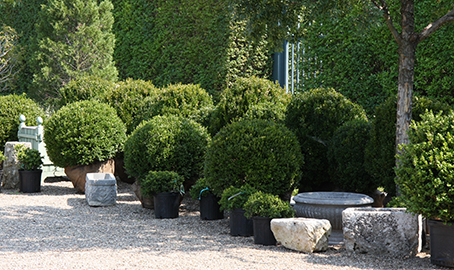 |
 |
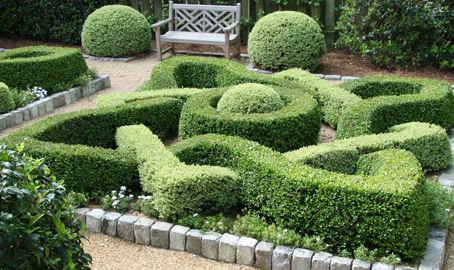 |
||
| NURSERY & CULTIVAR INFORMATION | CONSULTATION, MANAGEMENT, RESTORATION & LECTURES | GARDEN DESIGN |
| AJF Design - P.O. Box 292 - Pottersville, NJ - 07979 |